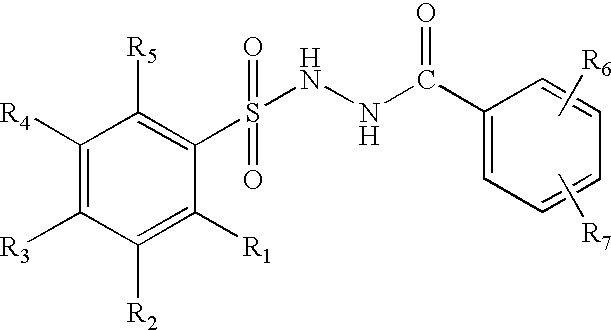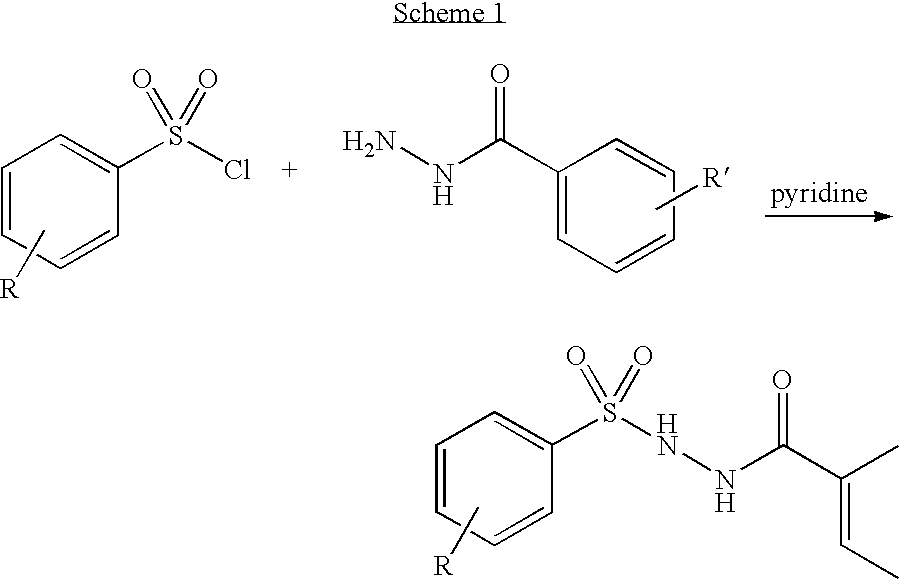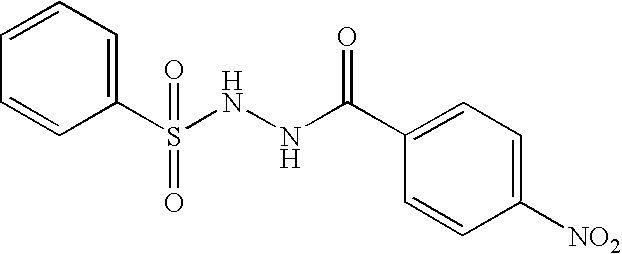Branched chain amino acid-dependent aminotransferase inhibitors and their use in the treatment of neurodegenerative diseases
a technology of aminotransferase inhibitors and amino acids, which is applied in the direction of biocide, drug composition, metabolic disorders, etc., can solve the problems of neurodegeneration and death, limited only by chemico-physical limitations
- Summary
- Abstract
- Description
- Claims
- Application Information
AI Technical Summary
Benefits of technology
Problems solved by technology
Method used
Image
Examples
example 2
Benzoic acid, 4-amino-2-(phenylsulfonyl)hydrazide ##STR4##
Synthesis of Example 2: Benzoic acid, 4-nitro-2-(phenylsulfonyl)hydrazide (0.82 g, Example 1) was dissolved in 50 mL of THF / EtOH (1:1), treated with wet Raney Nickel (0.6 g) and hydrogenated at 50 psi for 15 hours. The reaction was filtered, concentrated in vacuum, and chromatographed on silica gel eluting with 6% MeOH / CH.sub.2 Cl.sub.2 to give 61 mg (84%) of the desired product. MS: 291.9 (M+1 for C.sub.13 H.sub.13 N.sub.3 O.sub.3 S.sub.1); mp 171-173.degree. C.; TLC (SiO.sub.2) R.sub.f =0.45 (8% MeOH / CH.sub.2 Cl.sub.2); HPLC (C18 column, 1:1 CH.sub.3 CN / H.sub.2 O+0.01%TFA) 99.14%, RT=2.575 min. HRMS (calc for M+1) 292.0756 (found) 292.0753. IR (KBr, cm.sup.-1): 3471, 3367, 3151, 2925, 1661,1 318, 1162. .sup.1 H NMR (DMSO-d.sub.6) .delta. 5.69 (s, 2H), 6.44 (d, 2H, J=8.5 Hz), 7.32-7.58 (m, 5H), 7.75-7.80 (m, 2H), 9.68 (br, 1H), 10.12 (br, 1H).
example 3
Benzoic acid, 4-[[(2,4,6trichlorophenyl)sulfonyl]amino]-, 2-(phenylsulfonyl)hydrazide ##STR5##
Benzoic acid, 4-amino-2-(phenylsulfonyl)hydrazide (0.15 g, 0.52 mmol, Example 2) was dissolved in 7 mL of dry pyridine, then 2,4,6-(trichlorophenyl)sulfonyl chloride (0.15 mL, 0.52 mmol) was added, and the reaction was stirred at 25.degree. C. for overnight. The solvent was removed, and the product was recrystalized from ethyl acetate and hexane to give 0.26 g (96%) of the product as a white solid. MS: 536.0 (M+1 for C.sub.19 H.sub.14 Cl.sub.3 N.sub.3 O.sub.5 S.sub.2); mp 195.7-196.2.degree. C.; HPLC (C18 column, 1:1 MeCN / H.sub.2 O+0.1% TFA) 96.3%, RT=8.0 min. .sup.1 H NMR (DMSO-D.sub.6) .delta. 7.10 (d, 1H, J=6.8 Hz), 7.40-7.60 (m, 7H), 7.75 (d, 1H, J=7.5 Hz), 7.79 (S, 1H), 8.63 (S, 1H), 9.92 (S, 1H), 10.49 (S, 1H), 11.35 (S, 1H).
EXAMPLE 4
Benzoic acid, 4-[[[4-(trifluoromethyl)phenyl]sulfonyl]amino]-, 2-(phenylsulfonyl)hydrazide ##STR6##
example 4
ed in accordance with the methods of Example 3 except that 4-[(trifluoromethyl)phenyl]sulfonyl chloride was used instead of 2,4,6-(trichlorophenyl)sulfonyl chloride (yield 92%). MS: 500.0 (M+1 for C.sub.20 H.sub.16 F.sub.3 N.sub.3 O.sub.5 S.sub.2): mp 98.5-99.4.degree. C.; HPLC (C18 column, 1:1 MeCN / H.sub.2 O+0.1% TFA) 96.8%, RT=6.1 min. .sup.1 H NMR(DMSO-D.sub.6) .delta. 7.10 (d, 1H, J=8.6 Hz), 7.40-7.60 (m, 5H), 7.76 (d, 1H, J=7.5 Hz), 7.86-8.06 (m, 5H), 8.63 (d, 1H, b J=4 Hz), 9.94 (S, 1H), 10.52 (S, 1H), 10.95 (S, 1H).
EXAMPLE 5
Benzoic acid, 4-[[(3,4-dimethoxyphenyl)sulfonyl]amino]-, 2-(phenylsulfonyl)hydrazide ##STR7##
PUM
| Property | Measurement | Unit |
|---|---|---|
| pH | aaaaa | aaaaa |
| pH | aaaaa | aaaaa |
| pH | aaaaa | aaaaa |
Abstract
Description
Claims
Application Information
 Login to View More
Login to View More - R&D
- Intellectual Property
- Life Sciences
- Materials
- Tech Scout
- Unparalleled Data Quality
- Higher Quality Content
- 60% Fewer Hallucinations
Browse by: Latest US Patents, China's latest patents, Technical Efficacy Thesaurus, Application Domain, Technology Topic, Popular Technical Reports.
© 2025 PatSnap. All rights reserved.Legal|Privacy policy|Modern Slavery Act Transparency Statement|Sitemap|About US| Contact US: help@patsnap.com



